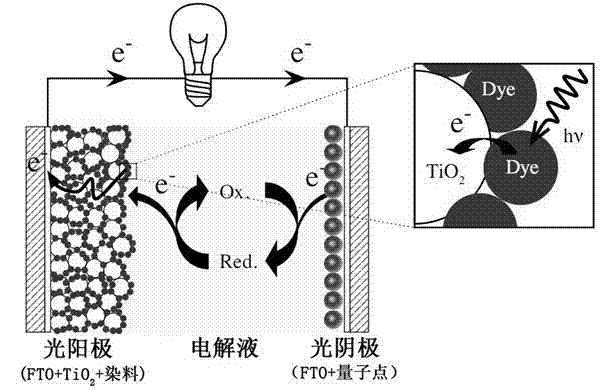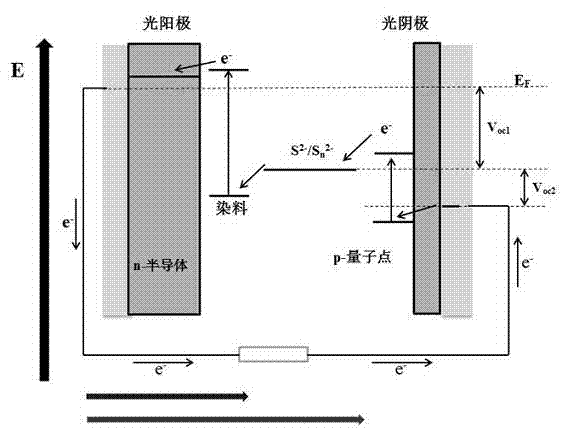Quantum dot and dye co-sensitization solar battery and preparation method thereof
A technology of solar cells and quantum dots, applied in the field of dye-sensitized solar cells, can solve the problems of difficulty in synergy, bottlenecks in efficiency improvement, etc., and achieve the effect of increasing open circuit voltage and expanding absorption spectrum.
- Summary
- Abstract
- Description
- Claims
- Application Information
AI Technical Summary
Problems solved by technology
Method used
Image
Examples
example 1
[0023] Example 1: Co-sensitized solar cells with N719 dye and PbS quantum dots
[0024] Step 1, 0.5g P25 type TiO 2 Nanoparticles were mixed with 0.2 g of ethyl cellulose, 0.5 mL of triton was added, dissolved in 5 mL of absolute ethanol, and the mixture was thoroughly mixed by stirring and sonication to make TiO 2 slurry; use a glass rod to mix the TiO 2 The paste is coated on the conductive glass, then at 550 o C was calcined for half an hour to obtain TiO 2 Nanoparticle film; the film thickness is controlled at 20 microns, and the film is soaked in 0.5mM N719 dye solution for 24 hours to make TiO 2 The surface is fully adsorbed with dye molecules to make a photoanode.
[0025] Step 2, using the chemical solution method to prepare PbS quantum dots: specifically, weigh 1.7mmol Pb(Ac) 2 Pour it into a three-necked bottle, measure 2 mL of oleic acid, and add 4 mL of diphenyl ether into the three-necked bottle; place the three-necked bottle in an oil bath, heat to 80 ° C, a...
example 2
[0030] Step 1, 0.5g P25 type TiO 2 Nanoparticles were mixed with 0.5 g of ethyl cellulose, 2 mL of triton was added, and dissolved in 8 mL of absolute ethanol; the mixture was thoroughly mixed by stirring and sonication to make TiO 2 slurry; use a glass rod to mix the TiO 2 The paste is coated on the conductive glass, then at 550 o C was calcined for half an hour to obtain TiO 2 Nanoparticle film, the film thickness is controlled at 15 microns, soak this film in 0.5mM D2 dye solution for 15 hours, make TiO 2 The surface is fully adsorbed with dye molecules to make a photoanode.
[0031] Step 2, put 0.2g cadmium acetate and 10g octadecylamine (ODA) into a three-necked flask at 70 o Stir under nitrogen protection for 20min to make it evenly mixed to form cadmium precursor liquid, mix 0.0264g sulfur powder and 8gODA into the reaction kettle, feed high-purity nitrogen and heat to 90 o C, form the precursor liquid of sulfur; Inject the precursor liquid of sulfur into the precu...
PUM
| Property | Measurement | Unit |
|---|---|---|
| Particle size | aaaaa | aaaaa |
| Thickness | aaaaa | aaaaa |
Abstract
Description
Claims
Application Information
 Login to View More
Login to View More - R&D
- Intellectual Property
- Life Sciences
- Materials
- Tech Scout
- Unparalleled Data Quality
- Higher Quality Content
- 60% Fewer Hallucinations
Browse by: Latest US Patents, China's latest patents, Technical Efficacy Thesaurus, Application Domain, Technology Topic, Popular Technical Reports.
© 2025 PatSnap. All rights reserved.Legal|Privacy policy|Modern Slavery Act Transparency Statement|Sitemap|About US| Contact US: help@patsnap.com



